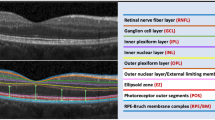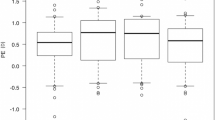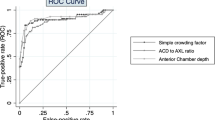Abstract
Purpose
To report relationship of age group and axial length (AL) category to lens thickness values in eyes with a clear lens or different types of isolated cataract (nuclear, cortical, and posterior subcapsular (PSC)). Further, we evaluated lens thickness values on anterior chamber depth (ACD) in these eyes.
Design
Observational clinic-based study.
Methods
An observational study of 1442 eyes of 1442 individuals (816 eyes with isolated cataract and 626 eyes with clear lens) of those above 25 years of age was evaluated. AL and lens thickness were performed with an A-scan ultrasound after dilatation of the pupil, and manual optical pachymetry was used to measure ACD after dilatation of the pupil.
Main outcome measures: Lens thickness.
Results
Multiple regression analysis revealed that with each decade of advancement in age, the lens thickness increased by 0.155 mm (P<0.001). The difference in lens thickness after adjusting for age group and AL category was less in cortical cataract by −0.25 mm (P<0.001) and PSC by −0.29 mm (P<0.001); With advancement in AL category, lens thickness decreased by 0.004 mm (P<0.001). After adjusting for all the parameters/variables, regression analysis revealed that as lens thickness increased, there was a significant decrease in ACD (mean −0.44 mm; P<0.001).
Conclusions
Lens thickness was significantly greater in clear lenses when compared with isolated cataracts—greatest with nuclear cataract and least with PSC. Age group and AL category had a significant impact on the lens thickness of both cataract and clear lens. A significant decrease in ACD was found with the increase in lens thickness.
Similar content being viewed by others
Log in or create a free account to read this content
Gain free access to this article, as well as selected content from this journal and more on nature.com
or
References
Hoffer KJ . Axial dimension of the human cataractous lens. Arch Ophthalmol 1993; 111: 914–918.
Adler FH . Physiology of the Eye, 4th ed. Mosby – Year Book: St Louis, MO, 1965; 280.
Roters S, Hellmich M, Szurman P . Prediction of axial length on the basis of vitreous body length and lens thickness. Retrospective echobiometric study. J Cataract Refract Surg 2002; 28: 853–859.
Koretz JF, Kaufman PL, Neider MW, Goeckner PA . Accomodation and presbyopia in the human eye aging of the anterior segment. Vis Res 1989; 29: 1685–1692.
Kashima K, Trus BL, Unser M, Edwards PA, Datiles MB . Aging studies on normal lens using the scheimpflug slit-lamp camera. Invest Ophthalmol Vis Sci 1993; 34: 263–269.
Klein BEK, Klein R, Moss SE . Correlates of lens thickness: the beaver dam eye study. Invest Ophthalmol Vis Sci 1998; 39: 1507–1510.
Sasaki H, Hockwin O, Kasuga T, Nagai K, Sakamoto Y, Sasaki K . An index for human lens transparency related to age and lens layer: comparison between normal volunteers and diabetics patients with still clear lenses. Ophthalmic Res 1999; 31: 93–103.
Pierro L, Brancate R, Zaganeli E, Guarisco L, Calori G . Correlation of lens thickness with blodd glucose control in diabetes mellitus. Acta Ophthalmol Scand 1996; 74: 539–541.
Logstrup N, Sjolie AK, Kyvik KO, Green A . Lens thickness and insulin dependent diabetes mellitus; a population based twin study. Br J Ophthalmol 1996; 80: 405–408.
Snydecker D . The relation of the volume if the crystalline lens to the depth of the anterior chamber. Trans Am Ophthalmol Soc 1956; 54: 675–708.
Scammon RE, Hesdorffer MB . Growth in mass volume of the human lens in postnatal life. Arch Ophthalmol 1937; 17: 104–112.
Bours J, Fodisch HJ . Human fetal lens: wet and weight with increasing gestational age. Ophthalmology 1986; 18: 363–368.
Blaker JW . Toward an adaptive model of the human eye. J Opt Soc Am 1980; 70: 220–223.
Koretz JF, Neider MW, Kaufman PL, Bertasso AM, DeRousseau CJ, Bito LZ . Slit-lamp studies of the rhesus monkey eye. I. Survey of the anterior segment. Exp Eye Res 1987; 44: 307–318.
Laursen AB, Fledelius H . Variations of lens thickness in relation to biomicroscopic types of human senile cataract. Acta Ophthalmologica 1978; 57: 1–13.
Logstrup N, Sjolie AK, Kyvik KO, Green A . Lens thickness and insulin dependent diabetes mellitus; a population based two study. Br J Ophthalmol 1996; 80 (5): 405–408.
Heyworth P, Thompson GM, Tabandeh H, McGuigan S . The relationship between clinical classification of cataract and lens hardness. Eye 1993; 7: 726–730.
Klein BE, Klein R, Moss SE . Lens thickness and five year cumulative incidence of cataracts: The Beaver Dam Eye Study. Ophthalmic Epidemiol 2000; 7: 243–248.
Mariani G, Mangili R . Differences in proteins and in the water balance of the lens in nuclear and cortical types of senile cataract. In: Philipson BT, Fagerholm PP (eds). The Human Lens in Relation to Cataract. Associated Scientific Publishers: Amsterdam, London Newyork, 79–97.
Mariani G, Pescatori A . Changes in weight and in protein water ratio of the lens in human senile cataract. Ophthalmol Res 1972; 3: 108–113.
Goldmann H, Favre M . Eine besondere ferm praeseniler kataract. Ophthalmologica 1961; 141: 418–422.
Nordmann J, Eisenkopf M . The thickness of the human lens cortex in the different types of senile cataract. Invest Ophthalmol Vis Sci 1976; 15: 425–427.
Lim R, Mitchell P, Cumming RG . Refractive association with cataract: the Blue Mountains Eye Study. Invest Ophthalmol Vis Sci 1999; 40: 3021–3026.
Wong TY, Klein BE, Klein R, Tomany SC, Lee KE . Refractive errors and incident cataracts: the Beaver Dam Eye Study. Invest Ophthalmol Vis Sci 2001; 42: 1449–1454.
Younan C, Mitchell P, Cumming RG, Rochtchina E, Wang JJ . Myopia and incident cataract and cataract surgery: the Blue Mountains Eye study. Invest Ophthalmol Vis Sci 2002; 43: 3325–3332.
Mutti DO, Zadnik K, Egashira S, Kish L, Twelker JD, Adams AJ . The effect of cycloplegia on measurement of the ocular components. Invest Ophthalmol Vis Sci 1994; 35: 515–527.
Author information
Authors and Affiliations
Corresponding author
Additional information
The authors have no financial or proprietary interest in any product mentioned here
Rights and permissions
About this article
Cite this article
Praveen, M., Vasavada, A., Shah, S. et al. Lens thickness of Indian eyes: impact of isolated lens opacity, age, axial length, and influence on anterior chamber depth. Eye 23, 1542–1548 (2009). https://doi.org/10.1038/eye.2008.315
Received:
Revised:
Accepted:
Published:
Issue date:
DOI: https://doi.org/10.1038/eye.2008.315
Keywords
This article is cited by
-
Senile Cataract Formation Does Not Affect Crystalline Lens Thickness
Ophthalmology and Therapy (2024)
-
Relationship between the main components of the crystalline lens and the anterior chamber depth after cataract formation
Graefe's Archive for Clinical and Experimental Ophthalmology (2023)
-
Comparison of anterior segment and lens biometric measurements in patients with cataract
Graefe's Archive for Clinical and Experimental Ophthalmology (2020)
-
Bilateral simultaneous acute angle closure attack triggered by an over-the-counter flu medication
International Ophthalmology (2018)
-
The distribution of axial length, anterior chamber depth, lens thickness, and vitreous chamber depth in an adult population of Shahroud, Iran
BMC Ophthalmology (2012)



